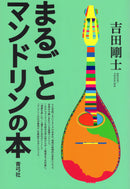Description
Written by Tsuyoshi Yoshida Seikyusha Publishing 46 size 264 pages
The mandolin was born in Italy around the 17th century and is a musical instrument that is loved all over the world for its unique lyrical tone. It was introduced to Japan with the civilization and enlightenment of the Meiji era, and spread throughout the country, mainly in university mandolin clubs, and became a huge boom, loved by many cultural figures, including Sakutaro Hagiwara and Masao Koga. Despite the fact that the number of players playing the mandolin is said to be the largest in the world, very few books have been published in Japan that comprehensively explain the mandolin.
This book is aimed at beginners who are just starting to play the mandolin, as well as intermediate and advanced players who have already played the mandolin to some extent, and is written by a professional mandolin player who is active on the front lines. and ``The depth of mandolin culture'' will be explained in detail in two stages.
We provide detailed explanations from the basics, such as how to choose an instrument, how to tune it, and how to change the strings, and cover practical topics such as how to join a local orchestra, how to find a teacher, how to hold an independent concert, and how to create a better sound. I'll cover it. Furthermore, it summarizes the history of the musical instrument that developed mainly in Naples, Italy, and the history of mandolin culture in Japan, and delves into deep themes such as the challenges faced by the mandolin industry and its future prospects.
This is a guidebook that helps beginners quickly discover the rich world of the mandolin, and is also a comprehensive book that summarizes the unlikely "history of Japanese mandolin culture."
【table of contents】
Introduction
Chapter 1 The charm of the mandolin
1 Instruments used in a wide range of genres
2 Beginner-friendly instruments
3 Unique tone
4 Instruments that can be played by one person or in a group, and that can be enjoyed by everyone for a long time
5 Instruments that capture the hearts of collectors
6 Differences and similarities with other musical instruments
Chapter 2 Basic knowledge of mandolin
1 Learn about the structure of musical instruments
2 Let's learn about strings
3 About string replacement
4 Picks are the most important accessory
5 Don't forget to maintain your instrument
6 Instruments of the mandolin family: mandola, mandoroncello, mandrone, and others
7 Various types of mandolin columns Why is the mandolin double-stringed?
Chapter 3: Get a mandolin
1 What kind of instruments are there?
2 How to choose a good instrument
3 Visit a specialty store
4 Visit a mandolin class
5 How to buy cheaply
6 About the case
7 Various prices of mandolins
8 Representative historical master craftsmen and their instruments
Chapter 4 Basic performance methods
1 Preparation before playing
2 The basics of the basics: how to play with the right hand and how to use the left hand
3 Slightly advanced playing and expression techniques
4 Other ways to play - Columns such as advanced playing methods, expressive techniques, special playing methods, etc. Differences between classical and bluegrass playing methods
Chapter 5: The world of music played with the mandolin
1 The mandolin is an instrument that is used in a wide range of genres.
2 Classification of “solo and ensemble”
3 The world of mandolin solo pieces - representative solo pieces, mandolin pieces by great composers
4 The world of mandolin ensembles - their organization and compositions
5 Bluegrass and Choro
6 Collaboration with other instruments, other genres, etc.
7 Get the sheet music
Chapter 6 History of the Mandolin
1 300 years of history of the mandolin
2 Birth of the mandolin
3 Various types of mandolins throughout history
4 The First Golden Age: The Mandolin Blooms in Paris in the 18th Century
5 Second Golden Age: The Age of Mandolin Virtuoso
6 History of the American Mandolin
7 History of Japanese Mandolin
8 Modern Japanese Mandolin Players and Leaders Column Mandolin in Literature and Movies
Chapter 7 Let's play together
1 The culture of mandolin ensembles
2 Japan is a mandolin powerhouse
3 Join the mandolin orchestra
4 About communication and manners
5 Basics of ensemble playing
6 About the structure and management of a mandolin orchestra
7 The world of mandolin ensembles
8 Mandolin world with a wide range of swings
9 Mandolin ensemble is best played live Do I have to be able to read sheet music?
Chapter 8 Expand your performance space
Let's perform in front of 1 person
2 Classroom and circle presentations
3 How to hold a concert
4 About the live house
5 How to create a live sound source
6 About stage talk
7 Internet Distribution Column What can I do to avoid getting caught on stage?
Chapter 9 For better performance
1 What is a good performance?
2 Effective practice process for better performance
3 Points for better performance
4 Performance with a sense of song
5 Difference between rhythm and mark division
6 Polishing your tone
7 Refine your basic skills
8 Knowing musical styles
9 Thinking and playing by yourself
10 Thinking deeply about tremolo
11 Points for a better tremolo
12 Column to consider tremolo for mandolin orchestra Words of poet Shinkichi Ito
Chapter 10 The future of the mandolin
1 Current status of the mandolin area
2 The story that the mandolin should tell
3 The mandolin ensemble continues-Despair and hope of the mandolin ensemble
4 How will we operate in a post-corona world?
Appendix: How to read the code table
in conclusion


